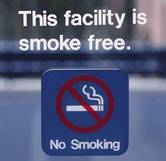
TUESDAY, May 14 (HealthDay News) — People who opt for nonsmoking rooms in hotels with a partial smoking ban are not fully protected from harmful exposure to so-called “thirdhand” smoke, according to a new study.
Smoking in hotels leaves a trail of tobacco pollution in the air and on surfaces in both smoking and nonsmoking rooms, researchers Georg Matt and colleagues at San Diego State University found. New hotels should enforce total smoking bans to protect their guests and employees, said the study authors, who also advised people to avoid hotels that allow smoking in designated areas.
“Our findings demonstrate that some nonsmoking guest rooms in smoking hotels are as polluted with [third-hand smoke] as are some smoking rooms,” the researchers wrote. “Moreover, nonsmoking guests staying in smoking rooms may be exposed to tobacco smoke pollutants at levels found among nonsmokers exposed to secondhand smoke.”
The study involved 40 budget-priced to mid-range hotels in San Diego. Of these hotels, 10 had complete smoking bans. Thirty hotels had partial smoking bans with designated nonsmoking rooms. The findings appeared online May 13 in the journal Tobacco Control.
The researchers examined the hotel rooms’ surfaces and air quality for evidence of nicotine and 3EP, a marker of tobacco smoke. Urine and finger wipe samples were also taken from nonsmokers who spent the night at any of the hotels to assess their exposure to nicotine and a carcinogen found in tobacco smoke known as NKK.
Nonsmoking rooms in hotels with partial smoking bans had evidence of air pollution. These designated nonsmoking rooms had levels of surface nicotine that were more than twice as high as rooms in hotels with total smoking bans, according to a journal news release.
These nonsmoking rooms had air levels of 3EP that were more than seven times as high as the rooms in hotels that did not permit any smoking.
In rooms designated as smoking areas, the researchers found that surface and air nicotine levels were 35 and 22 times higher than the rooms in hotels that had total smoking bans. The air nicotine levels in smoking rooms were also much higher than nonsmoking rooms.
Even the nonsmoking rooms of hotels with partial smoking bans had air nicotine levels that were 40 percent higher than in rooms in hotels with total smoking bans.
The effects of smoking were not confined to the hotel rooms. The study also showed that hallway surfaces outside of smoking rooms had higher nicotine levels than the surfaces outside nonsmoking rooms.
The samples taken from nonsmokers who stayed in hotels with partial smoking bans had higher levels of nicotine and NKK than those staying in nonsmoking hotels.
“Guests who wish to protect themselves from exposure to tobacco smoke should avoid hotels that permit smoking and instead stay in completely smoke-free hotels,” the researchers wrote.
More information
Visit the U.S. Centers for Disease Control and Prevention to learn more about tobacco use and smoke-free policies.

